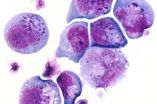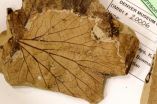(Press-News.org) WASHINGTON, DC – September 14, 2014 – A new clinical trial comparing the use of everolimus-eluting stents (EES) and drug-eluting balloons (DEB) in treating in-stent restenosis (ISR) from drug-eluting stents found that EES provided superior late angiographic results and better late clinical outcomes.
Findings were reported today at the 26th annual Transcatheter Cardiovascular Therapeutics (TCT) scientific symposium. Sponsored by the Cardiovascular Research Foundation (CRF), TCT is the world's premier educational meeting specializing in interventional cardiovascular medicine.
Treatment of patients with ISR remains a challenge, especially in patients presenting with drug-eluting stent (DES) ISR. In this setting, DEB appear to be as effective as first generation DES. However, the relative value of DEB compared to new generation DES with DES-ISR remains unknown.
RIBS IV was a multicenter prospective randomized trial that compared the efficacy of DEB with that of EES in patients with DES-ISR. The primary endpoint was minimal lumen diameter (MLD) at late angiographic follow up. Secondary endpoints including diameter stenosis, angiographic late lumen loss, and binary restenosis were also analyzed at nine months.
A total of 309 patients with DES-ISR were randomized to receive either EES (n=155) or DEB (n=154). Late angiographic follow up was obtained in 90 percent of eligible patients. At nine months, the EES group reported a larger in-segment MLD than the DEB group (2.03 vs. 1.80, respectively; p=0.004). After one year, the EES group also reported higher rates of freedom from target lesion revascularization (96 percent vs. 87 percent, p=0.008) and freedom from major adverse coronary events, including cardiac death, myocardial infarction, and target vessel revascularizaiton (90 percent vs. 82 percent, p=0.044).
"In patients with DES-ISR, our study found that EES provides superior late angiographic results and better late clinical outcomes compared to DEB," said lead investigator Fernando Alfonso, MD, PhD. Dr. Alfonso is the Head of the Cardiac Department at the Hospital Universitario de La Princesa in Madrid, Spain. "Treatment of DES-ISR remains challenging and associated with poorer clinical and angiographic results than treatment of bare metal stent ISR. Further studies with more patients and longer follow-up are warranted in this adverse setting."
The RIBS IV trial was an investigator driven initiative funded by unrestricted grants from B. Braun and Abbot Vascular. Dr. Alfonso reported no disclosures.
INFORMATION:
The results of the RIBS IV trial will be presented on Sunday, September 14 at 11:42 AM EDT in the Main Arena (Level 3, Ballroom) of the Walter E. Washington Convention Center.
About CRF and TCT
The Cardiovascular Research Foundation (CRF) is an independent, academically focused nonprofit organization dedicated to improving the survival and quality of life for people with heart disease through high quality research and education. Since its inception in 1991, CRF has played a major role in realizing dramatic improvements in the lives of countless numbers of patients by establishing the safe use of new technologies and therapies in interventional cardiovascular medicine.
Transcatheter Cardiovascular Therapeutics (TCT) is the annual scientific symposium of CRF and the world's premier educational meeting specializing in interventional cardiovascular medicine. For more than 25 years, TCT has featured major medical research breakthroughs and gathered leading researchers and clinicians from around the world to present and discuss the latest evidence-based research in the field.
For more information, visit http://www.crf.org and http://www.tctconference.com.
Results of RIBS IV trial reported at TCT 2014
New study finds everolimus-eluting stents provide superior clinical outcomes compared to drug-eluting balloons in patients with drug-eluting stent restenosis
2014-09-16
ELSE PRESS RELEASES FROM THIS DATE:
UTMB professor implements lifesaving protocol for school children with severe allergies
2014-09-16
As the number of children with food allergies in the U.S. increases, so does the risk of children having a severe, potentially life-threatening allergic reaction called anaphylaxis on school campuses. School nurses often have treatment plans in place for students with diagnosed allergies, but many children have their first allergic reactions at school, where a specific medication, such as EpiPen epinephrine injectors, may not be available and a response protocol may not be in place.
Students with identified food allergies are generally well known to school nurses. School ...
Healthy humans make nice homes for viruses
2014-09-16
The same viruses that make us sick can take up residence in and on the human body without provoking a sneeze, cough or other troublesome symptom, according to new research at Washington University School of Medicine in St. Louis.
On average, healthy individuals carry about five types of viruses on their bodies, the researchers report online in BioMed Central Biology. The study is the first comprehensive analysis to describe the diversity of viruses in healthy people.
The research was conducted as part of the Human Microbiome Project, a major initiative funded by the ...
Benefit of endocrine therapy in elderly women with low risk hormone receptor positive breast cancer?
2014-09-16
Treatment with endocrine therapy and radiation therapy as part of breast conservation is the current standard of care for women with hormone-receptor positive (HR+) invasive breast cancer. A new study by researchers at Fox Chase Cancer Center, however, shows that combination may not be necessary for all patient populations with the disease.
The results, which Fox Chase researchers presented at the American Society for Radiation Oncology's 56th Annual Meeting on Sunday, September 14, suggest that low-risk patients over 65 years old with small tumors may achieve comparable ...
Study identifies when and how much various prostate cancer treatments will impact urinary and sexual functioning
2014-09-16
Men with prostate cancer may one day be able to predict when and how much various treatments will impact their urinary and sexual functioning, thanks in part to new findings that researchers at Fox Chase Cancer Center presented at the American Society for Radiation Oncology's 56th Annual Meeting on Tuesday, September 16.
Looking over data gathered from more than 17,000 surveys completed by men diagnosed with prostate cancer, Fox Chase researchers tracked when patients' urinary and sexual symptoms changed following each type of treatment, and by how much. "The ultimate ...
World Health Organization policy improves use of medicines
2014-09-16
In this issue of PLOS Medicine, Kathleen Holloway from WHO and David Henry (University of Toronto, Canada) evaluated data on reported adherence to WHO essential medicines practices and measures of quality use of medicines from 56 low and middle income countries for 2002-2008. They compared the countries' government-reported implementation of 36 essential medicines policies with independent survey results for 10 validated indicators of quality use of medicines (QUM). They claim that the results provide the strongest evidence to date that WHO essential medicines policies ...
Access to female-controlled contraception needed in intimate partner violence
2014-09-16
Access to female-controlled contraceptive methods must be improved in order to help women and girls to counteract any risks to their reproductive health caused by intimate partner violence and reproductive coercion,* according to US experts writing in this week's PLOS Medicine.
Jay Silverman and Anita Raj from the University of California in San Diego explain that intimate partner violence is a major contributor to poor reproductive outcomes, such as unintended pregnancy, among women and girls around the world.
The authors argue that to improve reproductive health, ...
Meteorite that doomed dinosaurs remade forests
2014-09-16
The meteorite impact that spelled doom for the dinosaurs 66 million years ago decimated the evergreens among the flowering plants to a much greater extent than their deciduous peers, according to a study led by UA researchers. The results are published in the journal PLOS Biology.
Applying biomechanical formulas to a treasure trove of thousands of fossilized leaves of angiosperms — flowering plants excluding conifers — the team was able to reconstruct the ecology of a diverse plant community thriving during a 2.2 million-year period spanning the cataclysmic impact event, ...
A novel therapy for sepsis?
2014-09-16
This release is available in Japanese.
A University of Tokyo research group has discovered that pentatraxin 3 (PTX3), a protein that helps the innate immune system target invaders such as bacteria and viruses, can reduce mortality of mice suffering from sepsis. This discovery may lead to a therapy for sepsis, a major cause of death in developed countries that is fatal in one in four cases.
Professor Takao Hamakubo's group at the Department of Quantitative Biology and Medicine, Research Center for Advanced Science and Technology (RCAST), have shown that PTX3 forms ...
Meteorite that doomed the dinosaurs helped the forests bloom
2014-09-16
66 million years ago, a 10-km diameter chunk of rock hit the Yukatan peninsula near the site of the small town of Chicxulub with the force of 100 teratons of TNT. It left a crater more than 150 km across, and the resulting megatsunami, wildfires, global earthquakes and volcanism are widely accepted to have wiped out the dinosaurs and made way for the rise of the mammals. But what happened to the plants on which the dinosaurs fed?
A new study led by researchers from the University of Arizona reveals that the meteorite impact that spelled doom for the dinosaurs also decimated ...
The genetics of coping with HIV
2014-09-16
We respond to infections in two fundamental ways. One, which has been the subject of intensive research over the years, is "resistance," where the body attacks the invading pathogen and reduces its numbers. Another, which is much less well understood, is "tolerance," where the body tries to minimise the damage done by the pathogen. Now an elegant study using data from a large Swiss cohort of HIV-infected individuals gives us a tantalising glimpse into why some people cope with HIV better than others.
The authors find that tolerance varies substantially between individuals, ...
LAST 30 PRESS RELEASES:
Structure of dopamine-releasing neurons relates to the type of circuits they form for smell-processing
Reducing social isolation protects the brain in later life
Keeping the heart healthy increases longevity even after cancer
Young adults commonly mix cannabis with nicotine and tobacco
Comprehensive review illuminates tau protein's dual nature in brain health, disease, and emerging psychiatric connections
Book prepares K-12 leaders for the next public health crisis
Storms in the Southern Ocean mitigates global warming
Seals on the move: Research reveals key data for offshore development and international ecology
Sports injuries sustained during your period might be more severe
World's first successful 2 Tbit/s free-space optical communication using small optical terminals mountable on satellites and HAPS
Can intimate relationships affect your heart? New study says ‘yes’
Scalable and healable gradient textiles for multi‑scenario radiative cooling via bicomponent blow spinning
Research shows informed traders never let a good climate crisis go to waste
Intelligent XGBoost framework enhances asphalt pavement skid resistance assessment
Dual-function biomaterials for postoperative osteosarcoma: Tumor suppression and bone regeneration
New framework reveals where transport emissions concentrate in Singapore
NTP-enhanced lattice oxygen activation in Ce-Co catalysts for low-temperature soot combustion
Synergistic interface engineering in Cu-Zn-Ce catalysts for efficient CO2 hydrogenation to methanol
COVID-19 leaves a lasting mark on the human brain
Scientists use ultrasound to soften and treat cancer tumors without damaging healthy tissue
Community swimming program for Black youth boosts skills, sense of belonging, study finds
Specific depressive symptoms in midlife linked to increased dementia risk
An ‘illuminating’ design sheds light on cholesterol
Who is more likely to get long COVID?
Study showcases resilience and rapid growth of “living rocks”
Naval Research Lab diver earns Office of Naval Research 2025 Sailor of the Year
New Mayo-led study establishes practical definition for rapidly progressive dementia
Fossil fuel industry’s “climate false solutions” reinforce its power and aggravate environmental injustice
Researchers reveal bias in a widely used measure of algorithm performance
Alcohol causes cancer. A study from IOCB Prague confirms damage to DNA and shows how cells defend against it
[Press-News.org] Results of RIBS IV trial reported at TCT 2014New study finds everolimus-eluting stents provide superior clinical outcomes compared to drug-eluting balloons in patients with drug-eluting stent restenosis



